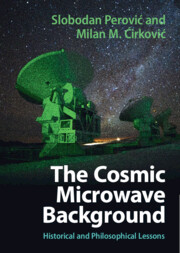Book contents
- The Cosmic Microwave Background
- The Cosmic Microwave Background
- Copyright page
- Epigraph
- Contents
- Acknowledgments
- Introduction
- Part I Physical cosmology: A brief introduction
- 1 Physical cosmology from Einstein to 1965
- 2 The “great controversy” (1948–1965) and epistemological issues it raised
- 3 Hot Big Bang and λCDM
- Part II Discovery of the CMB and current cosmological orthodoxy
- Part III What constitutes an unorthodoxy? An epistemological framework of cosmology
- Part IV Moderate unorthodoxies: The CMB with the Big Bang
- Part V Radical unorthodoxies: The CMB without the Big Bang
- Part VI Formation of the orthodoxy and the alternatives: Epistemological lessons
- Part VII Other philosophically relevant aspects of the CMB
- Book part
- Notes
- References
- Index
2 - The “great controversy” (1948–1965) and epistemological issues it raised
from Part I - Physical cosmology: A brief introduction
Published online by Cambridge University Press: aN Invalid Date NaN
- The Cosmic Microwave Background
- The Cosmic Microwave Background
- Copyright page
- Epigraph
- Contents
- Acknowledgments
- Introduction
- Part I Physical cosmology: A brief introduction
- 1 Physical cosmology from Einstein to 1965
- 2 The “great controversy” (1948–1965) and epistemological issues it raised
- 3 Hot Big Bang and λCDM
- Part II Discovery of the CMB and current cosmological orthodoxy
- Part III What constitutes an unorthodoxy? An epistemological framework of cosmology
- Part IV Moderate unorthodoxies: The CMB with the Big Bang
- Part V Radical unorthodoxies: The CMB without the Big Bang
- Part VI Formation of the orthodoxy and the alternatives: Epistemological lessons
- Part VII Other philosophically relevant aspects of the CMB
- Book part
- Notes
- References
- Index
Summary
The chapter discusses the “great controversy” of modern cosmology. The controversy began after World War II and lasted for a couple of decades. In the controversy, the proponents of various iterations of the steady-state theory of the universe collided with the pioneers of the emerging big-bang expanding universe theory. The latter theory triumphed, while establishing empirical standards of cosmological theories and breaking the stigma of cosmology as an unscientific subject that lurked in the science community. Parsimonious observational criteria were devised for the key cosmological parameters, including the age of the universe, source counts, redshift–magnitude relation, and redshift–angular size relationship. The chapter also discusses how the relation between redshift in the spectrum and magnitude was pioneered by Hubble and slowly perfected by tests on different celestial objects, from galaxies to Type Ia supernova stars.
Keywords
- Type
- Chapter
- Information
- The Cosmic Microwave BackgroundHistorical and Philosophical Lessons, pp. 9 - 12Publisher: Cambridge University PressPrint publication year: 2024



